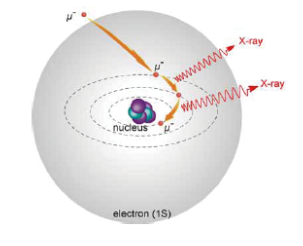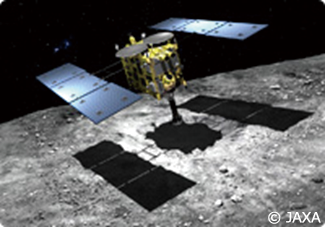Materials Structure Science Program > Neutron / Muon > Muon science group
Muon science group
● Main research projects
[Research on the technology of sophisticated muon beams]
Ultraslow muon microscope
The slow (surface) 4-MeV muon beam, which converges to Φ70 mm using a superconducting axial focusing magnet system, is injected into a target (high-temperature tungsten foil) and instantaneously decelerates to 0.2 eV, to generate muonium (Mu: the bound system positive muon and electron). The decelerated muons evaporate from the tungsten target as thermal Mu and are excited from 1s to 2p by 122-nm Lyman-α laser light. Electrons in Mu are stripped by 355-nm and Lyman-α laser lights and the thermal Mu is converted to ultraslow muon. It is possible to extract ultraslow muons by using an SOA lens and a quadrupole lens to the nano-metre μSR spectroscopy. Independently we are planning to accelerate them to make a micro beam by the induction acceleration.
 members, Dr.Miyake (left) and Dr. Shimomura (right).
members, Dr.Miyake (left) and Dr. Shimomura (right).
超低速ミュオン顕微鏡の詳細 → 超低速ミュオン顕微鏡と極微μSR法創成 A01班
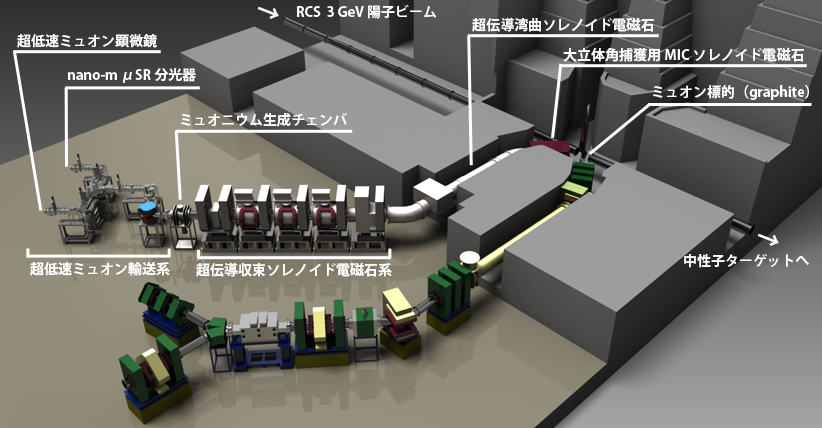
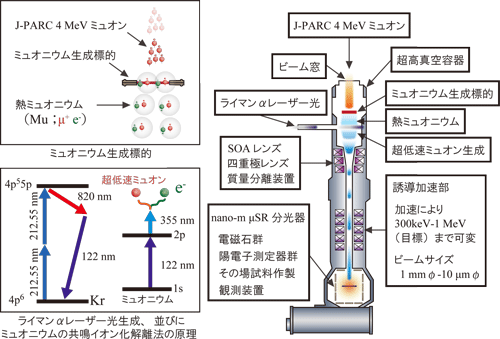
Image of the muon beamline in the second experimental hall at the Materials and Life Science Experimental Facility at J-PARC. Top: ultraslow muon beamline (U-line). Bottom: general-purpose muon beamline (D-line). (超低速ミュオン顕微鏡: Ultraslow muon microscope, 分光器: Spectrometer, ミュオニウム生成チェンバ: Muonium generation chamber, 超低速ミュオン輸送系: Ultraslow muon transport system, 超伝導収束ソレノイド電磁石系: Superconducting axial focusing magnet system, 陽子ビーム: Proton beam, 超伝導湾曲ソレノイド電磁石: Superconducting curved solenoid magnet, 大立体角捕獲用MICソレノイド電磁石: MIC solenoid magnet for large solid angle capture, ミュオン標的: Muon target 中性子ターゲットへ: To neutron target)
[Nondestructive element analysis method using negative muons]
Nondestructive analysis of a sample from an asteroid using muonic X-rays -conducted as a collaborative research project by Osaka University and the Institute of Materials Structure Science at KEK-
Muonic X-rays are characteristic X-rays that are emitted from an element that absorbed negative muons. They have a great ability to penetrate matter; therefore, it is possible to detect any signal from deep inside a sample. This way we can analyze rare samples in a nondestructive way.
[Material science research using muons]
Research on hydrogen electron structures in industrial materials -performed to find the origin of n-type electric conductivity in gallium nitride-
Hydrogen atoms are key players in semiconductors and significantly influence bulk electrical activity; however, it is extremely difficult to conduct research on very-low-density hydrogen (isolated hydrogen center). We observed the electronic structure of an isolated muonium center in a semiconductor using high-time-resolution μSR and simulated isolated hydrogen. A small activation energy was observed, which indicates an isolated hydrogen forms a shallow donor. The results strongly indicate the origin of n-type conductivity in GaN by unintentional hydrogen.
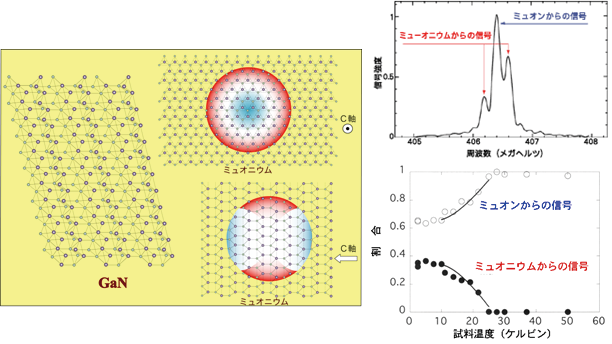
Shimomura, Kadono et al. PRL 92 (2004) 135505
Observation of Li(Na) diffusion in Li(Na) battery materials
Liquid batteries are used in cars, but development of all-solid batteries is underway to save on weight and space. Development of such a battery requires a way to continuously measure the motion of Li, including at the interfaces between the cathode, the solid electrolyte, and the anode.
Members
| Name | Position | Fields |
|---|---|---|
| SHIMOMURA, Koichiro | Professor | Materials Science with Muons, Ultra Slow Muons |
| KAWAMURA, Naritoshi | Assoc.Professor | muon science, muon catalyzed fusion, beam physics |
| OISHI, Yu | Assoc.Professor | Laser engineering physics, Ultra Slow Muons |
| NAGATANI, Yukinori | Assoc.Professor | |
| STRASSER, Patrick | Assoc.Professor | Particle accelerators, X-ray spectroscopy, Muon science, Accelerator physics |
| KANDA, Sohtaro | Assistant Professor | |
| YAMAZAKI, Takayuki | Assistant Professor | |
| MIYAKE, Yasuhiro | Researcher (KEK) | Ultra slow muon, Laser, Nondestructive analysis |
● Link
Muon Science Laboratory http://msl-www.kek.jp/folder_Eng/index_en.html

